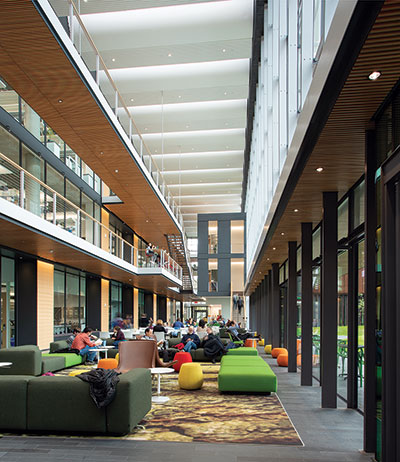
On the occasion of Amherst’s Bicentennial, we present a series of excerpts from Amherst College: The Campus Guide. This is the first of four. The book is one of the keepsake Bicentennial books commissioned by the College.

On the occasion of Amherst’s Bicentennial, we present a series of excerpts from Amherst College: The Campus Guide. This is the first of four. The book is one of the keepsake Bicentennial books commissioned by the College.

At 255,000 square feet, the new Science Center is by far the biggest building on Amherst’s campus. It has more square footage than the combined total of the two buildings it replaced, the Merrill Science Center and the McGuire Life Sciences Building. Amherst has long prided itself on architecture that reflects its core identity as an intimate college, not an impersonal university. So the Science Center’s sheer size invariably raised the fraught question: Is bigger better? The architects have confronted this challenge intelligently, if imperfectly.
The E-shaped structure, largely framed in concrete, consists of five main parts: to the east, a four-story “lab bar” that contains teaching and research laboratories; in the center, a light-filled atrium, called the Science Commons, that runs the length of the building; and, to the west, three projecting pavilions, two- to three-stories high, that contain classrooms, faculty offices, greenhouses and a science library. The Science Center’s chief occupants are the departments of biology, chemistry, computer science, psychology, and physics and astronomy, as well as the biochemistry and biophysics program, plus the neuroscience program. While the building provides state-of-the-art research facilities and accommodates a major increase in enrollment in STEM classes, it is a resource for the entire campus.
Fitting all these uses into a single structure without overwhelming the human scale of Amherst’s campus posed an enormous challenge. The architectural firm, Payette, which also designed the Beneski Earth Sciences Building and Museum of Natural History, responded by following the precedent of the college’s previous science and math buildings; they buried a portion of the center’s ground floor in its hillside site. But this hill is nowhere near as steep as the ones that conceal the mass of Merrill and McGuire. So, at first glance, the center looks too big—not because it’s too tall but because it’s so long. How long? If you took the five buildings of College Row—Johnson Chapel, North, South, Appleton and Williston Halls—and pushed them together, they would occupy roughly the same footprint as the Science Center. That’s long—too long. Worse, when seen from afar, the perforated weathered steel that clads the center’s three pavilions appears monolithic and impenetrable.
Give the center a chance, however, and it offers much that is appealing.It effectively frames the Greenway’s eastern edge, and its pavilions enclose garden courtyards that integrate the center with the Greenway’s sculpted landscape. The center’s height and low-slung proportions, accentuated by a cantilevered canopy and solar array, are in keeping with the horizontal contours of the campus; they also maintain views of the Pelham Hills from the area off the main quadrangle. The end walls sheathed in long, textured gray brick, relate well to the granite cladding of the nearby Wieland and King Halls. At close range, the weathered steel looks more like a delicate veil than a blunt wall.
Best of all is the building’s inviting transparency, which comes courtesy of its west-facing façade—a triple-layered, four-story wall of energy-efficient glass that hangs like a curtain from the structural steel that spans the Science Commons. What a difference from Merrill’s nearly windowless brick walls! The expanse of glass exemplifies what the architects call biophilic design, which seeks to make strong connections between a building’s interior and its natural surroundings by providing abundant natural light, views of the landscape and natural ventilation.

The inner views are equally impressive. Glass-walled labs line the commons’s east side, showcasing beakers, fume hoods and microscopes. The transparency makes science seem a little less intimidating; it may also make students working deep into the night feel less isolated in their labs. Thoughtfully arranged adjacencies, like an area for student write-ups placed just outside the chemistry labs, foster the chance for students to participate in hands-on research and become coauthors on scientific articles. Lecture halls are set deep inside the building, avoiding the perimeter lecture halls that contributed to Merrill’s much-faulted front.
To be sure, many of the expectations for the center echo the ones that were raised for Merrill decades ago and never realized. Only time will tell whether the center lives up to its promise of adaptability. Yet the building already has exceeded expectations by attracting droves of nonscience students and encouraging a new level of interaction among faculty and staff members. The design compellingly fuses an expression of scientific precision with responsiveness to nature and a demonstration of environmental stewardship. It reflects the values and visions of its time, just as Amherst’s first buildings made indelible statements about their own era.